Tutorial: Send notifications to specific users by using Azure Notification Hubs
Overview
This tutorial describes how to use Azure Notification Hubs to send push notifications to a specific app user on a specific device. An ASP.NET WebAPI backend is used to authenticate clients. When the backend authenticates a client application user, it automatically adds a tag to the notification registration. The backend uses this tag to send notifications to the specific user.
Note
The completed code for this tutorial can be found on GitHub.
In this tutorial, you take the following steps:
- Create the WebAPI project
- Authenticate clients to the WebAPI backend
- Register for notifications by using the WebAPI backend
- Send notifications from the WebAPI backend
- Publish the new WebAPI backend
- Update the code for the client project
- Test the application
Prerequisites
This tutorial builds on the notification hub and Visual Studio project that you created in the Tutorial: Send notifications to Universal Windows Platform apps by using Azure Notification Hubs tutorial. Therefore, complete it before starting on this tutorial.
Note
If you are using Mobile Apps in Azure App Service as your backend service, see the Mobile Apps version of this tutorial.
Create the WebAPI project
The following sections discuss the creation of a new ASP.NET WebAPI backend. This process has three main purposes:
- Authenticate clients: You add a message handler to authenticate client requests and associate the user with the request.
- Register for notifications by using the WebAPI backend: You add a controller to handle new registrations for a client device to receive notifications. The authenticated username is automatically added to the registration as a tag.
- Send notifications to clients: You add a controller to provide a way for users to trigger a secure push to devices and clients associated with the tag.
Create the new ASP.NET Core 6.0 web API backend by doing the following actions:
To check, start Visual Studio. On the Tools menu, select Extensions and Updates. Search for NuGet Package Manager in your version of Visual Studio, and make sure you have the latest version. If your version is not the latest version, uninstall it, and then reinstall the NuGet Package Manager.
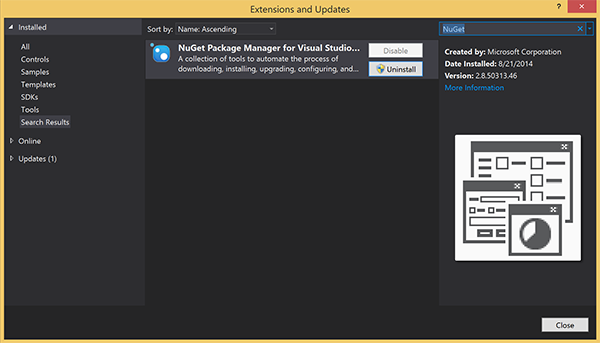
Note
Make sure you have installed the Visual Studio Azure SDK for website deployment.
Start Visual Studio or Visual Studio Express.
Select Server Explorer, and sign in to your Azure account. To create the web site resources on your account, you must be signed in.
In Visual Studio's File menu, select New > Project.
Enter Web API in the search box.
Select the ASP.NET Core Web API project template and select Next.
In the Configure your new project dialog, name the project AppBackend and select Next.
In the Additional information dialog:
- Confirm the Framework is .NET 6.0 (Long-term support).
- Confirm the checkbox for Use controllers(uncheck to use minimal APIs) is checked.
- Uncheck Enable OpenAPI support.
- Select Create.
Remove the WeatherForecast template files
- Remove the WeatherForecast.cs and Controllers/WeatherForecastController.cs example files from the new AppBackend project.
- Open Properties\launchSettings.json.
- Change launchUrl properties from weatherforcast to appbackend.
In the Configure Microsoft Azure Web App window, select a subscription and then, in the App Service plan list, do either of the following actions:
- Select an Azure App Service plan that you've already created.
- Select Create a new app service plan, and then create one.
You do not need a database for this tutorial. After you have selected your app service plan, select OK to create the project.
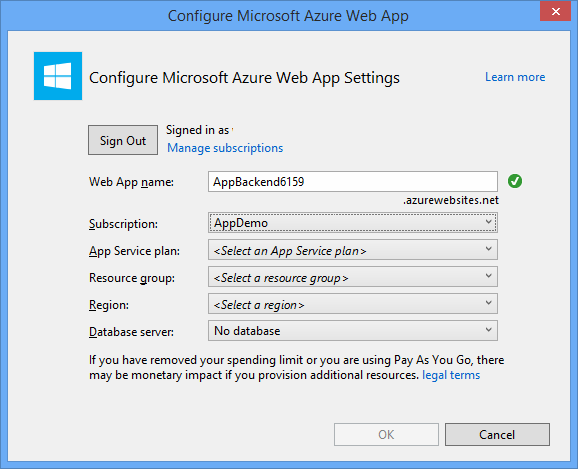
If you don't see this page for configure app service plan, continue with the tutorial. You can configure it while publishing the app later.
Authenticate clients to the WebAPI backend
In this section, you create a new message-handler class named AuthenticationTestHandler for the new backend. This class is derived from DelegatingHandler and added as a message handler so that it can process all requests that come into the backend.
In Solution Explorer, right-click the AppBackend project, select Add, and then select Class.
Name the new class AuthenticationTestHandler.cs, and then select Add to generate the class. This class authenticates users by using Basic Authentication for simplicity. Your app can use any authentication scheme.
In AuthenticationTestHandler.cs, add the following
usingstatements:using System.Net.Http; using System.Threading; using System.Security.Principal; using System.Net; using System.Text; using System.Threading.Tasks;In AuthenticationTestHandler.cs, replace the
AuthenticationTestHandlerclass definition with the following code:The handler authorizes the request when the following three conditions are true:
- The request includes an Authorization header.
- The request uses basic authentication.
- The user name string and the password string are the same string.
Otherwise, the request is rejected. This authentication is not a true authentication and authorization approach. It is only a simple example for this tutorial.
If the request message is authenticated and authorized by
AuthenticationTestHandler, the basic authentication user is attached to the current request on HttpContext. User information in HttpContext will be used by another controller (RegisterController) later to add a tag to the notification registration request.public class AuthenticationTestHandler : DelegatingHandler { protected override Task<HttpResponseMessage> SendAsync( HttpRequestMessage request, CancellationToken cancellationToken) { var authorizationHeader = request.Headers.GetValues("Authorization").First(); if (authorizationHeader != null && authorizationHeader .StartsWith("Basic ", StringComparison.InvariantCultureIgnoreCase)) { string authorizationUserAndPwdBase64 = authorizationHeader.Substring("Basic ".Length); string authorizationUserAndPwd = Encoding.Default .GetString(Convert.FromBase64String(authorizationUserAndPwdBase64)); string user = authorizationUserAndPwd.Split(':')[0]; string password = authorizationUserAndPwd.Split(':')[1]; if (VerifyUserAndPwd(user, password)) { // Attach the new principal object to the current HttpContext object HttpContext.Current.User = new GenericPrincipal(new GenericIdentity(user), new string[0]); System.Threading.Thread.CurrentPrincipal = System.Web.HttpContext.Current.User; } else return Unauthorized(); } else return Unauthorized(); return base.SendAsync(request, cancellationToken); } private bool VerifyUserAndPwd(string user, string password) { // This is not a real authentication scheme. return user == password; } private Task<HttpResponseMessage> Unauthorized() { var response = new HttpResponseMessage(HttpStatusCode.Forbidden); var tsc = new TaskCompletionSource<HttpResponseMessage>(); tsc.SetResult(response); return tsc.Task; } }Note
Security note: The
AuthenticationTestHandlerclass does not provide true authentication. It is used only to mimic basic authentication and is not secure. You must implement a secure authentication mechanism in your production applications and services.To register the message handler, add the following code at the end of the
Registermethod in the Program.cs file:config.MessageHandlers.Add(new AuthenticationTestHandler());Save your changes.
Register for notifications by using the WebAPI backend
In this section, you add a new controller to the WebAPI backend to handle requests to register a user and a device for notifications by using the client library for notification hubs. The controller adds a user tag for the user that was authenticated and attached to HttpContext by AuthenticationTestHandler. The tag has the string format, "username:<actual username>".
In Solution Explorer, right-click the AppBackend project and then select Manage NuGet Packages.
In the left pane, select Online and then, in the Search box, type Microsoft.Azure.NotificationHubs.
In the results list, select Microsoft Azure Notification Hubs, and then select Install. Complete the installation, and then close the NuGet Package Manager window.
This action adds a reference to the Azure Notification Hubs SDK by using the Microsoft.Azure.Notification Hubs NuGet package.
Create a new class file that represents the connection with the notification hub that's used to send notifications. In Solution Explorer, right-click the Models folder, select Add, and then select Class. Name the new class Notifications.cs, and then select Add to generate the class.
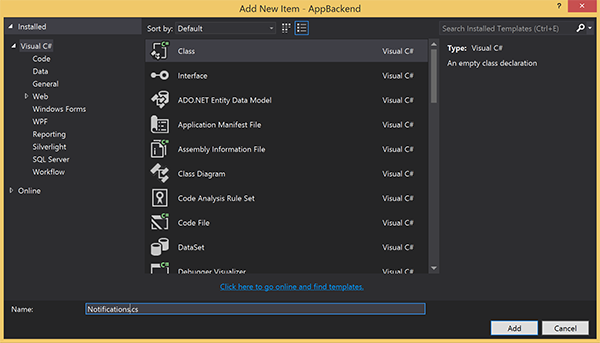
In Notifications.cs, add the following
usingstatement at the top of the file:using Microsoft.Azure.NotificationHubs;Replace the
Notificationsclass definition with the following code, and replace the two placeholders with the connection string (with full access) for your notification hub and the hub name (available at Azure portal):public class Notifications { public static Notifications Instance = new Notifications(); public NotificationHubClient Hub { get; set; } private Notifications() { Hub = NotificationHubClient.CreateClientFromConnectionString("<your hub's DefaultFullSharedAccessSignature>", "<hub name>"); } }Important
Enter the name and the DefaultFullSharedAccessSignature of your hub before proceeding further.
Next, create a new controller named RegisterController. In Solution Explorer, right-click the Controllers folder, select Add, and then select Controller.
Select API Controller - Empty, and then select Add.
In the Controller name box, type RegisterController to name the new class, and then select Add.
In RegisterController.cs, add the following
usingstatements:using Microsoft.Azure.NotificationHubs; using Microsoft.Azure.NotificationHubs.Messaging; using AppBackend.Models; using System.Threading.Tasks; using System.Web;Add the following code inside the
RegisterControllerclass definition. In this code, you add a user tag for the user that's attached to HttpContext. The user was authenticated and attached to HttpContext by the message filter that you added,AuthenticationTestHandler. You can also add optional checks to verify that the user has rights to register for the requested tags.private NotificationHubClient hub; public RegisterController() { hub = Notifications.Instance.Hub; } public class DeviceRegistration { public string Platform { get; set; } public string Handle { get; set; } public string[] Tags { get; set; } } // POST api/register // This creates a registration id public async Task<string> Post(string handle = null) { string newRegistrationId = null; // make sure there are no existing registrations for this push handle (used for iOS and Android) if (handle != null) { var registrations = await hub.GetRegistrationsByChannelAsync(handle, 100); foreach (RegistrationDescription registration in registrations) { if (newRegistrationId == null) { newRegistrationId = registration.RegistrationId; } else { await hub.DeleteRegistrationAsync(registration); } } } if (newRegistrationId == null) newRegistrationId = await hub.CreateRegistrationIdAsync(); return newRegistrationId; } // PUT api/register/5 // This creates or updates a registration (with provided channelURI) at the specified id public async Task<HttpResponseMessage> Put(string id, DeviceRegistration deviceUpdate) { RegistrationDescription registration = null; switch (deviceUpdate.Platform) { case "mpns": registration = new MpnsRegistrationDescription(deviceUpdate.Handle); break; case "wns": registration = new WindowsRegistrationDescription(deviceUpdate.Handle); break; case "apns": registration = new AppleRegistrationDescription(deviceUpdate.Handle); break; case "fcm": registration = new FcmRegistrationDescription(deviceUpdate.Handle); break; default: throw new HttpResponseException(HttpStatusCode.BadRequest); } registration.RegistrationId = id; var username = HttpContext.Current.User.Identity.Name; // add check if user is allowed to add these tags registration.Tags = new HashSet<string>(deviceUpdate.Tags); registration.Tags.Add("username:" + username); try { await hub.CreateOrUpdateRegistrationAsync(registration); } catch (MessagingException e) { ReturnGoneIfHubResponseIsGone(e); } return Request.CreateResponse(HttpStatusCode.OK); } // DELETE api/register/5 public async Task<HttpResponseMessage> Delete(string id) { await hub.DeleteRegistrationAsync(id); return Request.CreateResponse(HttpStatusCode.OK); } private static void ReturnGoneIfHubResponseIsGone(MessagingException e) { var webex = e.InnerException as WebException; if (webex.Status == WebExceptionStatus.ProtocolError) { var response = (HttpWebResponse)webex.Response; if (response.StatusCode == HttpStatusCode.Gone) throw new HttpRequestException(HttpStatusCode.Gone.ToString()); } }Save your changes.
Send notifications from the WebAPI backend
In this section, you add a new controller that exposes a way for client devices to send a notification. The notification is based on the username tag that uses Azure Notification Hubs .NET Library in the ASP.NET WebAPI backend.
Create another new controller named NotificationsController the same way you created RegisterController in the previous section.
In NotificationsController.cs, add the following
usingstatements:using AppBackend.Models; using System.Threading.Tasks; using System.Web;Add the following method to the NotificationsController class:
This code sends a notification type that's based on the Platform Notification Service (PNS)
pnsparameter. The value ofto_tagis used to set the username tag on the message. This tag must match a username tag of an active notification hub registration. The notification message is pulled from the body of the POST request and formatted for the target PNS.Depending on the PNS that your supported devices use to receive notifications, the notifications are supported by a variety of formats. For example, on Windows devices, you might use a toast notification with WNS that isn't directly supported by another PNS. In such an instance, your backend needs to format the notification into a supported notification for the PNS of devices you plan to support. Then use the appropriate send API on the NotificationHubClient class.
public async Task<HttpResponseMessage> Post(string pns, [FromBody]string message, string to_tag) { var user = HttpContext.Current.User.Identity.Name; string[] userTag = new string[2]; userTag[0] = "username:" + to_tag; userTag[1] = "from:" + user; Microsoft.Azure.NotificationHubs.NotificationOutcome outcome = null; HttpStatusCode ret = HttpStatusCode.InternalServerError; switch (pns.ToLower()) { case "wns": // Windows 8.1 / Windows Phone 8.1 var toast = @"<toast><visual><binding template=""ToastText01""><text id=""1"">" + "From " + user + ": " + message + "</text></binding></visual></toast>"; outcome = await Notifications.Instance.Hub.SendWindowsNativeNotificationAsync(toast, userTag); break; case "apns": // iOS var alert = "{\"aps\":{\"alert\":\"" + "From " + user + ": " + message + "\"}}"; outcome = await Notifications.Instance.Hub.SendAppleNativeNotificationAsync(alert, userTag); break; case "fcm": // Android var notif = "{ \"data\" : {\"message\":\"" + "From " + user + ": " + message + "\"}}"; outcome = await Notifications.Instance.Hub.SendFcmNativeNotificationAsync(notif, userTag); break; } if (outcome != null) { if (!((outcome.State == Microsoft.Azure.NotificationHubs.NotificationOutcomeState.Abandoned) || (outcome.State == Microsoft.Azure.NotificationHubs.NotificationOutcomeState.Unknown))) { ret = HttpStatusCode.OK; } } return Request.CreateResponse(ret); }To run the application and ensure the accuracy of your work so far, select the F5 key. The app opens a web browser, and it is displayed on the ASP.NET home page.
Publish the new WebAPI backend
Next, you deploy the app to an Azure website to make it accessible from all devices.
Right-click the AppBackend project, and then select Publish.
Select Microsoft Azure App Service as your publish target, and then select **Publish. The Create App Service window opens. Here you can create all the necessary Azure resources to run the ASP.NET web app in Azure.
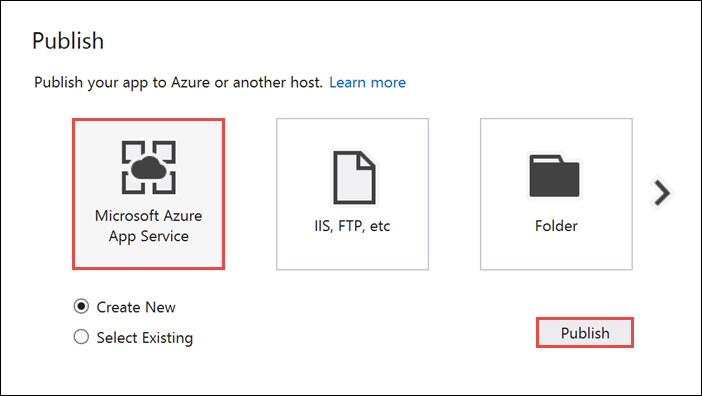
In the Create App Service window, select your Azure account. Select Change Type > Web App. Keep the default Web App Name, and then select the Subscription, Resource Group, and App Service Plan.
Select Create.
Make a note of the Site URL property in the Summary section. This URL is your back-end endpoint later in the tutorial.
Select Publish.
After you've completed the wizard, it publishes the ASP.NET web app to Azure and then opens the app in the default browser. Your application is viewable in Azure App Services.
The URL uses the web app name that you specified earlier, with the format http://<app_name>.azurewebsites.net.
Update the code for the UWP client
In this section, you update the code in the project you completed for the Tutorial: Send notifications to Universal Windows Platform apps by using Azure Notification Hubs tutorial. The project should already be associated with the Windows store. It also should be configured to use your notification hub. In this section, you add code to call the new WebAPI backend and use it for registering and sending notifications.
In Visual Studio, open the solution you created for the Tutorial: Send notifications to Universal Windows Platform apps by using Azure Notification Hubs.
In Solution Explorer, right-click the Universal Windows Platform (UWP) project and then click Manage NuGet Packages.
On the left-hand side, select Browse.
In the Search box, type Http Client.
In the results list, click System.Net.Http, and click Install. Complete the installation.
Back in the NuGet Search box, type Json.net. Install the Newtonsoft.json package, and then close the NuGet Package Manager window.
In Solution Explorer, in the WindowsApp project, double-click MainPage.xaml to open it in the Visual Studio editor.
In the
MainPage.xamlfile, replace the<Grid>section with the following code: This code adds a username and password textbox that the user authenticates with. It also adds text boxes for the notification message and the username tag that should receive the notification:<Grid> <Grid.RowDefinitions> <RowDefinition Height="Auto"/> <RowDefinition Height="*"/> </Grid.RowDefinitions> <TextBlock Grid.Row="0" Text="Notify Users" HorizontalAlignment="Center" FontSize="48"/> <StackPanel Grid.Row="1" VerticalAlignment="Center"> <Grid> <Grid.RowDefinitions> <RowDefinition Height="Auto"/> <RowDefinition Height="Auto"/> <RowDefinition Height="Auto"/> <RowDefinition Height="Auto"/> <RowDefinition Height="Auto"/> <RowDefinition Height="Auto"/> <RowDefinition Height="Auto"/> <RowDefinition Height="Auto"/> <RowDefinition Height="Auto"/> <RowDefinition Height="Auto"/> <RowDefinition Height="Auto"/> </Grid.RowDefinitions> <Grid.ColumnDefinitions> <ColumnDefinition></ColumnDefinition> <ColumnDefinition></ColumnDefinition> <ColumnDefinition></ColumnDefinition> </Grid.ColumnDefinitions> <TextBlock Grid.Row="0" Grid.ColumnSpan="3" Text="Username" FontSize="24" Margin="20,0,20,0"/> <TextBox Name="UsernameTextBox" Grid.Row="1" Grid.ColumnSpan="3" Margin="20,0,20,0"/> <TextBlock Grid.Row="2" Grid.ColumnSpan="3" Text="Password" FontSize="24" Margin="20,0,20,0" /> <PasswordBox Name="PasswordTextBox" Grid.Row="3" Grid.ColumnSpan="3" Margin="20,0,20,0"/> <Button Grid.Row="4" Grid.ColumnSpan="3" HorizontalAlignment="Center" VerticalAlignment="Center" Content="1. Login and register" Click="LoginAndRegisterClick" Margin="0,0,0,20"/> <ToggleButton Name="toggleWNS" Grid.Row="5" Grid.Column="0" HorizontalAlignment="Right" Content="WNS" IsChecked="True" /> <ToggleButton Name="toggleFCM" Grid.Row="5" Grid.Column="1" HorizontalAlignment="Center" Content="FCM" /> <ToggleButton Name="toggleAPNS" Grid.Row="5" Grid.Column="2" HorizontalAlignment="Left" Content="APNS" /> <TextBlock Grid.Row="6" Grid.ColumnSpan="3" Text="Username Tag To Send To" FontSize="24" Margin="20,0,20,0"/> <TextBox Name="ToUserTagTextBox" Grid.Row="7" Grid.ColumnSpan="3" Margin="20,0,20,0" TextWrapping="Wrap" /> <TextBlock Grid.Row="8" Grid.ColumnSpan="3" Text="Enter Notification Message" FontSize="24" Margin="20,0,20,0"/> <TextBox Name="NotificationMessageTextBox" Grid.Row="9" Grid.ColumnSpan="3" Margin="20,0,20,0" TextWrapping="Wrap" /> <Button Grid.Row="10" Grid.ColumnSpan="3" HorizontalAlignment="Center" Content="2. Send push" Click="PushClick" Name="SendPushButton" /> </Grid> </StackPanel> </Grid>In Solution Explorer, open the
MainPage.xaml.csfile for the (Windows 8.1) and (Windows Phone 8.1) projects. Add the followingusingstatements at the top of both files:using System.Net.Http; using Windows.Storage; using System.Net.Http.Headers; using Windows.Networking.PushNotifications; using Windows.UI.Popups; using System.Threading.Tasks;In
MainPage.xaml.csfor the WindowsApp project, add the following member to theMainPageclass. Be sure to replace<Enter Your Backend Endpoint>with your actual backend endpoint obtained previously. For example,http://mybackend.azurewebsites.net.private static string BACKEND_ENDPOINT = "<Enter Your Backend Endpoint>";Add the code below to the MainPage class in
MainPage.xaml.csfor the (Windows 8.1) and (Windows Phone 8.1) projects.The
PushClickmethod is the click handler for the Send Push button. It calls the backend to trigger a notification to all devices with a username tag that matches theto_tagparameter. The notification message is sent as JSON content in the request body.The
LoginAndRegisterClickmethod is the click handler for the Login and register button. It stores the basic authentication token (represents any token your authentication scheme uses) in local storage, then usesRegisterClientto register for notifications using the backend.private async void PushClick(object sender, RoutedEventArgs e) { if (toggleWNS.IsChecked.Value) { await sendPush("wns", ToUserTagTextBox.Text, this.NotificationMessageTextBox.Text); } if (toggleFCM.IsChecked.Value) { await sendPush("fcm", ToUserTagTextBox.Text, this.NotificationMessageTextBox.Text); } if (toggleAPNS.IsChecked.Value) { await sendPush("apns", ToUserTagTextBox.Text, this.NotificationMessageTextBox.Text); } } private async Task sendPush(string pns, string userTag, string message) { var POST_URL = BACKEND_ENDPOINT + "/api/notifications?pns=" + pns + "&to_tag=" + userTag; using (var httpClient = new HttpClient()) { var settings = ApplicationData.Current.LocalSettings.Values; httpClient.DefaultRequestHeaders.Authorization = new AuthenticationHeaderValue("Basic", (string)settings["AuthenticationToken"]); try { await httpClient.PostAsync(POST_URL, new StringContent("\"" + message + "\"", System.Text.Encoding.UTF8, "application/json")); } catch (Exception ex) { MessageDialog alert = new MessageDialog(ex.Message, "Failed to send " + pns + " message"); alert.ShowAsync(); } } } private async void LoginAndRegisterClick(object sender, RoutedEventArgs e) { SetAuthenticationTokenInLocalStorage(); var channel = await PushNotificationChannelManager.CreatePushNotificationChannelForApplicationAsync(); // The "username:<user name>" tag gets automatically added by the message handler in the backend. // The tag passed here can be whatever other tags you may want to use. try { // The device handle used is different depending on the device and PNS. // Windows devices use the channel uri as the PNS handle. await new RegisterClient(BACKEND_ENDPOINT).RegisterAsync(channel.Uri, new string[] { "myTag" }); var dialog = new MessageDialog("Registered as: " + UsernameTextBox.Text); dialog.Commands.Add(new UICommand("OK")); await dialog.ShowAsync(); SendPushButton.IsEnabled = true; } catch (Exception ex) { MessageDialog alert = new MessageDialog(ex.Message, "Failed to register with RegisterClient"); alert.ShowAsync(); } } private void SetAuthenticationTokenInLocalStorage() { string username = UsernameTextBox.Text; string password = PasswordTextBox.Password; var token = Convert.ToBase64String(System.Text.Encoding.UTF8.GetBytes(username + ":" + password)); ApplicationData.Current.LocalSettings.Values["AuthenticationToken"] = token; }Open
App.xaml.csand find the call toInitNotificationsAsync()in theOnLaunched()event handler. Comment out or delete the call toInitNotificationsAsync(). The button handler initializes notification registrations:protected override void OnLaunched(LaunchActivatedEventArgs e) { //InitNotificationsAsync();Right-click the WindowsApp project, click Add, and then click Class. Name the class
RegisterClient.cs, then click OK to generate the class.This class wraps the REST calls required to contact the app backend, in order to register for push notifications. It also locally stores the registrationIds created by the Notification Hub as detailed in Registering from your app backend. It uses an authorization token stored in local storage when you click the Login and register button.
Add the following
usingstatements at the top of the RegisterClient.cs file:using Windows.Storage; using System.Net; using System.Net.Http; using System.Net.Http.Headers; using Newtonsoft.Json; using System.Threading.Tasks; using System.Linq;Add the following code inside the
RegisterClientclass definition:private string POST_URL; private class DeviceRegistration { public string Platform { get; set; } public string Handle { get; set; } public string[] Tags { get; set; } } public RegisterClient(string backendEndpoint) { POST_URL = backendEndpoint + "/api/register"; } public async Task RegisterAsync(string handle, IEnumerable<string> tags) { var regId = await RetrieveRegistrationIdOrRequestNewOneAsync(); var deviceRegistration = new DeviceRegistration { Platform = "wns", Handle = handle, Tags = tags.ToArray<string>() }; var statusCode = await UpdateRegistrationAsync(regId, deviceRegistration); if (statusCode == HttpStatusCode.Gone) { // regId is expired, deleting from local storage & recreating var settings = ApplicationData.Current.LocalSettings.Values; settings.Remove("__NHRegistrationId"); regId = await RetrieveRegistrationIdOrRequestNewOneAsync(); statusCode = await UpdateRegistrationAsync(regId, deviceRegistration); } if (statusCode != HttpStatusCode.Accepted && statusCode != HttpStatusCode.OK) { // log or throw throw new System.Net.WebException(statusCode.ToString()); } } private async Task<HttpStatusCode> UpdateRegistrationAsync(string regId, DeviceRegistration deviceRegistration) { using (var httpClient = new HttpClient()) { var settings = ApplicationData.Current.LocalSettings.Values; httpClient.DefaultRequestHeaders.Authorization = new AuthenticationHeaderValue("Basic", (string) settings["AuthenticationToken"]); var putUri = POST_URL + "/" + regId; string json = JsonConvert.SerializeObject(deviceRegistration); var response = await httpClient.PutAsync(putUri, new StringContent(json, Encoding.UTF8, "application/json")); return response.StatusCode; } } private async Task<string> RetrieveRegistrationIdOrRequestNewOneAsync() { var settings = ApplicationData.Current.LocalSettings.Values; if (!settings.ContainsKey("__NHRegistrationId")) { using (var httpClient = new HttpClient()) { httpClient.DefaultRequestHeaders.Authorization = new AuthenticationHeaderValue("Basic", (string)settings["AuthenticationToken"]); var response = await httpClient.PostAsync(POST_URL, new StringContent("")); if (response.IsSuccessStatusCode) { string regId = await response.Content.ReadAsStringAsync(); regId = regId.Substring(1, regId.Length - 2); settings.Add("__NHRegistrationId", regId); } else { throw new System.Net.WebException(response.StatusCode.ToString()); } } } return (string)settings["__NHRegistrationId"]; }Save all your changes.
Test the Application
Launch the application on both Windows.
Enter a Username and Password as shown in the screen below. It should differ from the user name and password you enter on Windows Phone.
Click Log in and register and verify a dialog shows that you have logged in. This code also enables the Send Push button.
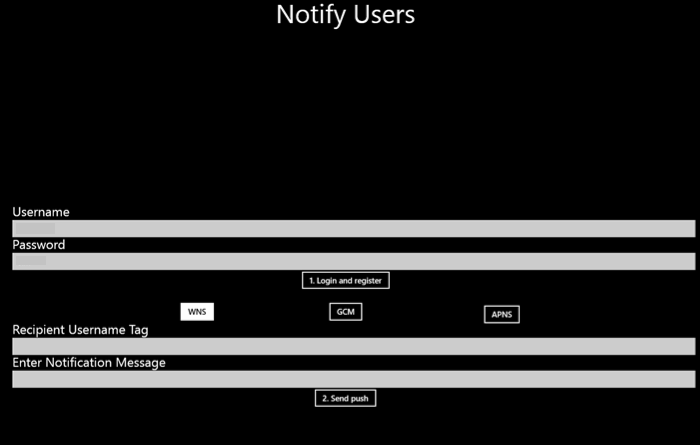
Then in the Recipient Username Tag field, enter the user name registered. Enter a notification message and click Send Push.
Only the devices that have registered with the matching username tag receive the notification message.
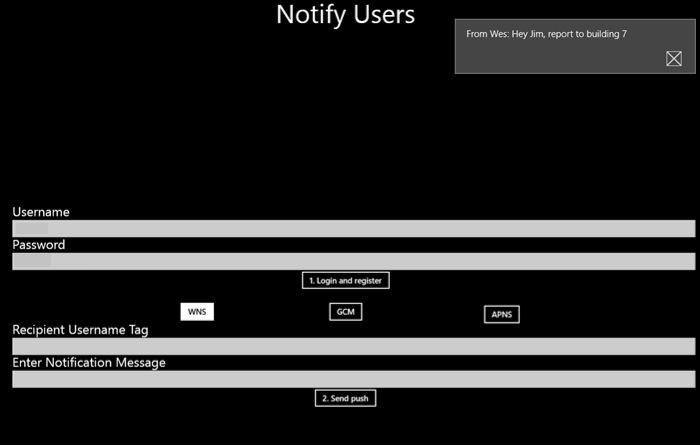
Next steps
In this tutorial, you learned how to push notifications to specific users that have tags associated with their registrations. To learn how to push location-based notifications, advance to the following tutorial:
